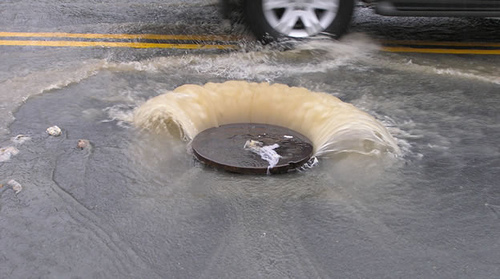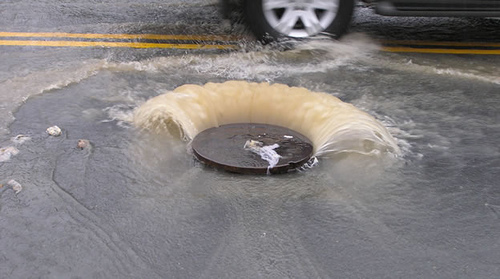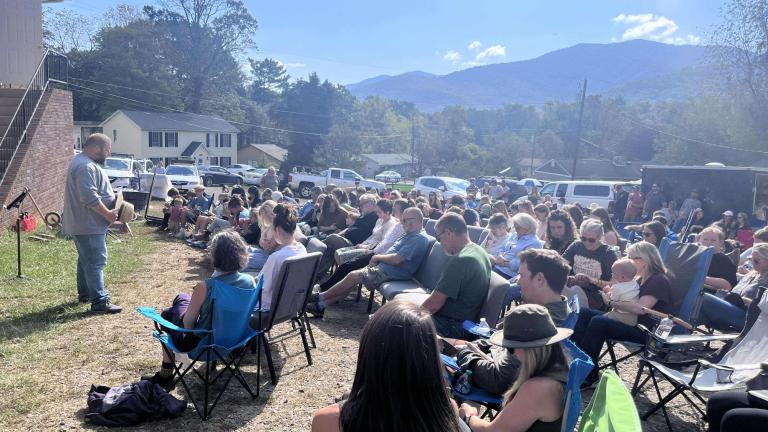 This is what a sewage system does when it is overwhelmed.Photo: Christopher ZurcherCross-posted from the NRDC‘s Smarter Cities.
This is what a sewage system does when it is overwhelmed.Photo: Christopher ZurcherCross-posted from the NRDC‘s Smarter Cities.
Every year nearly 30 billion gallons of wastewater filled with untreated sewage and pollution overflows into New York City’s waterways. Last week New York Mayor Michael Bloomberg and the Department of Environmental Protection unveiled a proposal for a new “NYC Green Infrastructure Plan” to help reduce the city’s serious sewage overflow problem.
The proposal has two key components: widespread use of green infrastructure in public spaces — such as green roofs, parks, tree boxes, roadside plantings, porous pavement in parking lots, cisterns, and rain barrels — as well as the establishment of design requirements for developers to ensure that all private property projects manage a minimum volume of stormwater on site. Green infrastructure not only naturally absorbs excess stormwater and thereby reduces runoff and sewage overflow, but it also improves the city’s livability by adding more greenery, boosting local jobs, and leading to cooler overall temperatures. Bloomberg proposes these measures, alongside improving existing ‘gray infrastructure’ such as storage tanks and tunnels. It’s a hybrid strategy that the city believes is cheaper and more efficient than simply building more traditional infrastructure.
During heavy rains New York City’s combined sewer systems — which funnel wastewater full of raw sewage to the city’s treatment plants — become flooded by rainwater that is loaded with pollution and litter from city streets. When it rains just a tenth of an inch, the sewer systems can become overwhelmed, dumping sewage and garbage into the city’s waterways — from the Hudson River and New York Harbor to the Bronx River and even out to the beaches on Long Island (watch a video of a sewage overflow into Brooklyn’s Gowanus Canal caught on camera by a couple of bystanders).
This happens more than 50 times a year. “Not only does this muck contain disease-causing bacteria and toxic chemicals that can make us sick,” said Larry Levine, senior attorney for NRDC’s Water and Oceans Programs. “It also fouls our waters with excessive nutrients that breed algae blooms, essentially choking ecologically sensitive marine life.”
In a press release dated Sept. 28, Mayor Bloomberg stated that the Green Infrastructure Plan will reduce the city’s sewage overflows by 12 billion gallons per year as well as “reduce long-term sewer management costs.” The city’s proposed hybrid green and gray strategy would invest $2.4 billion over 20 years (which includes about $900 million spent by private property owners to comply with new regulations). [Ed. note: These figures were revised after publication.] NRDC’s director of New York City Environment, Eric Goldstein, said in a recent article in the New York Times that “there will be some spirited negotiations to secure agreement on the all-important details,” but that the plan is a step “in the right direction.”
Levine says “NYC’s plan is definitely ambitious” however, he points out that “right now Philadelphia has the most ambitious plan. Philadelphia proposes to install enough green infrastructure in 20 years to handle virtually all of the stormwater runoff from 20 percent of the sewer system’s drainage area. In comparison, NYC proposes 10 percent in 20 years.
“The meat of the plan in NYC isn’t developed quite to the point of Philly’s plan yet,” Levine adds. “Importantly, it remains to be seen whether the city can make last week’s proposal part of a broader strategy to reduce sewer overflows and achieve ‘fishable and swimmable’ waters — which is the core goal of the Clean Water Act.”



